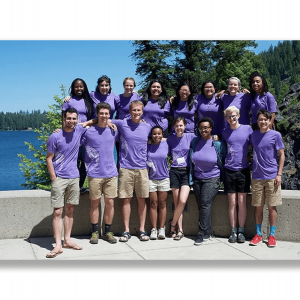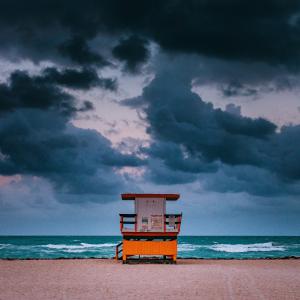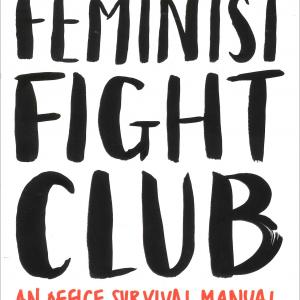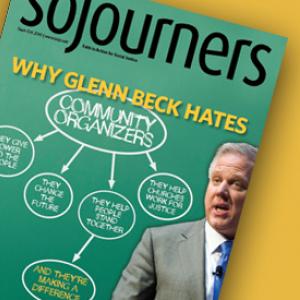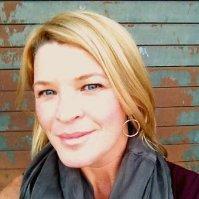
Julienne Gage is a Miami-based journalist who investigates economic development in the U.S. and Caribbean.
Posts By This Author
Idealism That Never Fades
A review of "Soul Space: Creating Places and Lives that Make a Difference," by Linda Lawrence Hunt
IT HAPPENS TO just about all of us who, in our early adulthood, commit ourselves to a life of globally conscious idealism. We run off to join a cause, maybe commit to a volunteer project for a year or two, come home, and find ourselves overwhelmed by how to create lasting change in a broken world.
Christian writers Jim and Linda Hunt struggled with this question in 1998, not so much as young people but as middle-age adults, after their daughter Krista perished in an accident in Bolivia. Krista and her husband Aaron were three years into their marriage and six months into a three-year service project teaching literacy and microenterprise with the Mennonite Central Committee, when the bus they were in plunged off a ravine.
How Rising Sea Levels Are Gentrifying Miami
Rich investors are buying up high ground—in historically black neighborhoods.
LESS THAN 100 YEARS AGO, the introduction of air conditioning made Miami one of the most desirable tourist destinations in America. Today, with a metro area population of nearly 3 million, it’s an even bigger cosmopolitan hot spot, with residents of all socioeconomic backgrounds vying for land in a sea of traffic and, to some degree, rising tides.
Like most of America’s urban centers, Miami is facing widespread gentrification. Plagued by limited public transportation and a desire to work and play in artsy urban districts, increasing numbers of affluent and middle-class residents have been moving inland, pushing immigrants, minorities, and the working class far into the suburbs or beyond county lines.
Climate change, according to some community activists, is exacerbating this phenomenon. In fact, it could soon make Miami a major U.S. focal point for climate justice.
Historically, being on the teal-colored ocean or bay was a priority for the privileged, so the poor were relegated to the interior—with black people specifically being subject to redlining and segregation—removed from much of what gave Miami the nickname “Magic City.” But on average, Miami is only about six and a half feet above sea level, so as the climate warms and tides rise, some investors and renters are moving inland, searching for higher ground in historically black neighborhoods such as Overtown, Liberty City, and Little Haiti. It’s a phenomenon local activist Valencia Gunder refers to as “climate gentrification.”
Gunder, 33, grew up in Liberty City, popularized by the Oscar-winning 2016 film Moonlight, which speaks to the juxtaposed joys and struggles of black Miami. This northwest neighborhood was built in the 1930s to alleviate population density in downtown Miami’s Overtown, one of the only neighborhoods for people of color during segregation. It accommodated middle-class African Americans with modest single-family homes and yards. Over the years, endemic poverty and racism would take its toll, as would South Florida’s tumultuous drug wars of the 1980s and 1990s. But Gunder says Liberty City still had a lot of perks.
Gangland
Mano Dura: The Politics of Gang Control in El Salvador, by Sonja Wolf. University of Texas Press.
THE MERE MENTION of maras—gangs that formed in the U.S. and then spread throughout Central America—conjures up overcrowded prisons filled with ominous-looking, elaborately tattooed Central American youth flashing gang signs. While this reality does exist, it’s part of what German scholar Sonja Wolf calls a folkloric attempt to demonize disenfranchised sectors of society rather than invest in comprehensive social programs.
Her new academic book, Mano Dura: The Politics of Gang Control in El Salvador, offers a far deeper analysis of public policy. It’s a must-read for any aid worker or missionary hoping to build peace and prosperity in a country with one of the highest homicide rates in the world—81 homicides per 100,000 people, eight times the U.N.’s marker for an epidemic. It also raises important questions about how much violence can actually be attributed to gangs when crime data is patchy and politicized.
The book, an updated version of Wolf’s 2008 doctoral dissertation in international politics, examines two decades of attempts to “pacify” El Salvador’s gangs, a subculture that diversified and expanded after El Salvador’s 1992 U.N.-sponsored peace accords. During the 12 years prior, a civil war claimed some 75,000 lives and prompted 1 million Salvadorans to seek refuge in the U.S. Some of these young refugees joined large U.S. gangs such as 18th Street or created their own, such as MS-13, then brought their gang affiliation back to El Salvador during mass deportations in the early 1990s.
What Entrepreneurs Can't Fix
The New Urban Crisis: How Our Cities are Increasing Inequality, Deepening Segregation, and Failing the Middle Class—and What We Can Do About It, by Richard Florida. Basic Books
FIFTEEN YEARS AGO, Richard Florida argued in The Rise of the Creative Class that cities fostering brainy interaction, creativity, and innovation would thrive, since modern capitalism was increasingly knowledge-based. His projections were acclaimed by artsy, back-to-the-city types (including many church planters) and scorned by activists and the low-income residents that gentrification displaced.
The critics were on to something, because since then many big cities have indeed gotten sexier, but not necessarily more reliable, especially for the masses. From 2006 to 2014, average incomes declined by 6 percent, while average rent prices soared by 22 percent. Today, about 21 million American renters are putting 30 to 50 percent of their income toward rent, with 30 percent representing the “cost-burdened” threshold.
How to Start Your Own Feminist Fight Club
According to author Jessica Bennett, just ask WWJD--What Would Josh Do?
WHEN AWARD_WINNING journalist Jessica Bennett published her saucy Feminist Fight Club: An Office Survival Manual (For a Sexist Workplace) in September 2016, it seemed reasonable to suggest “recognizing sexism is harder than it once was.”
That was before then-presidential candidate Donald Trump claimed in one debate that his rival Hillary Clinton didn’t have the presidential “look” and called her a “nasty woman” in another, and before the leak of a 2005 tape in which Trump boasted of grabbing women’s genitals, which he defended as “locker room talk.”
But blatant sexism doesn’t cancel out the less-obvious forms. Bennett addresses a variety of modern workplace scenarios—from fighting to get a word in edgewise and negotiating equal pay and maternity leave to naming and confronting sexual harassment—with statistical evidence and creative strategies. The latter run from the subtle yet assertive “I have another idea to throw out” in response to male dismissal or interruption to the more overt “Are you her tampon?” when a man asks if a co-worker is on her period.
Like many Gen-Xers who came of age after the feminist revolution, Bennett’s awakening was gradual. She started her career as a Newsweek reporter in 2005. Until she got there, she knew nothing of the 46 female Newsweek employees who, decades earlier, successfully sued over gender discrimination when they found they had been hired as researchers for male reporters on grounds that “women don’t write.”
Making Peace in a Powder Keg
Kenya is home to 70 languages, 42 ethnic groups, and at least one terrorist organization. Young peace activists are bridging these differences, one issue at a time.
IN DECEMBER 2007, Naomi Mwangi, a Christian, fled her home in Kisumu, Kenya, as men with machetes attacked towns across the region. For five weeks violence raged nationwide. When the bloodshed ended, more than 1,300 Kenyans were dead and another 650,000 had been displaced. Mwangi and her family ended up living in the Maai Mahiu refugee camp, south of Nairobi. She was 12 years old.
Mwangi is coming of age in a society with ethnic violence in the background, extremist violence in the foreground, and massive economic inequality. Africa has the highest concentration of young people in the world and more than half of them are unemployed. Mwangi wanted something different—she wanted to work for peace.
Now 21, Mwangi is a leader in grassroots peacemaking campaigns that seek to end conflicts between the 42 ethnic groups in this majority-Christian country. The 2007 election violence pitted Christian against Christian, as ethnic ties trumped religious affiliation. Even now, during elections, Mwangi told Sojourners, “Leaders motivate youth to join in the political crisis ... to fight against another tribe.”
A major obstacle to social and economic stability among youth in Kenya is unequal distribution of government-issued identification cards. Kenyans need ID cards for everything from voting and university enrollment to obtaining grants for entrepreneurship programs. But historically, the ruling government doled them out as political favors, and they’ve often been denied to members of minority groups.
“There are plenty of applications at election time,” Mwangi said, explaining that the ID process is slowed down or delayed when it seems one ethnic group could tip the chances of a politician who represents a different group.
Staying Connected in Later Years
"With a Little Help from Our Friends: Creating Community as We Grow Older," Vanderbilt University Press
IN THE U.S., mention of “aging in community” might conjure up images of weathered faces in nursing homes and snowbirds in South Florida. And yet, as increasing numbers of Americans reach the golden years—and do so in an uncertain economy—so do the array of scenarios for those growing older. Award-winning journalist Beth Baker traveled across the U.S. to document the possibilities in her latest book, With a Little Help from Our Friends: Creating Community as We Grow Older.
Some of her findings aren’t so surprising. Baby boomers have a stronger desire for independence than did their predecessors, and they aren’t keen on being tagged “elderly.” In fact, they generally see themselves in a different cohort than those born just prior to the boom.
Whether you’re in one of the aforementioned age groups or a diligent millennial thinking way ahead, Baker shows that imagining how you’ll one day balance independence with human connection in your older years doesn’t have to be daunting.
“That we can raise this question is remarkable. Never before have older people, often through their own imagination and determination, had real options from which to choose,” she writes.
Life After A Death
"Pilgrimage through Loss: Pathways to Strength and Renewal after the Death of a Child" by Linda Lawrence Hunt, Westminster John Knox Press
IN 1998, AWARD-WINNING writer Linda Lawrence Hunt and her husband, Jim, were forced to consider a question no parent wants to ask: How do you find meaning in life after losing your child?
Their 25-year-old daughter, Krista Hunt Ausland, had just died in a bus accident in Bolivia while volunteering with the Mennonite Central Committee.
“Your joys become more intense,” consoled a friend whose family had also lost a child.
This resonated with Linda, especially since Krista was known for her energy and enthusiasm. Linda and her husband, now retired professors of English and history at Whitworth University, had always encouraged Krista to travel and take part in community service, but even they were amazed by the intense joy Krista exuded serving as a school teacher in inner-city Tacoma, Wash., or volunteering in poor communities in Latin America. Writing about that joy might help to recover some of it in Linda’s own life, she thought.
Fifteen years later, Linda’s newest book is more than just an ode to a remarkably happy daughter. Pilgrimage through Loss: Pathways to Strength and Renewal after the Death of a Child is a collection of ideas and insight from more than 30 parents who decide in their darkest hours to “face grief in creative and intentional ways.” The book, which contains study questions at the end of each chapter and references new research on grief, is intended as a resource for grieving parents, as well as for those hoping to support them in the right ways and at the right times. “Closure is an illusion,” explains Linda, but she describes multiple examples of parents finding strength and even joy in sacred spaces and rituals, as well as in giving and receiving symbolic acts of kindness.
All in the Family
Churches in the "127 Movement" are opening their hearts, homes, and families to welcome children in the foster care system.
FROM EGG FREEZING to genome analysis, desirous parents with sufficient funds these days have many choices for starting a family. But what about children born to parents who can’t care for them—at least not at the present time? With 400,000 children in foster systems across the United States and a quarter of them awaiting adoption, it is a pressing question.
Some evangelicals increasingly are taking their cue from a particular biblical passage in the first chapter of James, verse 27: “Religion that is pure and undefiled before God ... is this: to care for orphans and widows in their distress ...”
From this verse has come the “127 movement,” dedicated to supporting prospective foster families within a church community. Project 1.27 in Colorado was the first group founded under this banner back in 2004. Its goal was to provide the state-mandated orientation and training, from a Christian perspective, to potential foster parents. If a family ended up fostering or later adopting a child, then the movement’s members would serve as a support network.
“We had 875 legally free kids waiting to be adopted in Colorado and twice that many churches,” recalled Project 1.27 director Shelly Radic. “We thought, ‘Wow, that’s just not right,’ so we began to build relationships with county social services and child services at the state level, and then connect with churches and private agencies to set up training.”
Since foster systems are run by individual states, so too are these faith-based support movements.
“We do recruiting, orientations, and training. We’re not a placement agency,” explained Radic. “We follow state guidelines, invite people to come who might be interested in foster care and adoption, tell them about the trauma and the hard things the children may have experienced, help families see what their process would look like, and talk about building a support team as a high priority.”
Gen Xers and the New Cuba
A new generation of Cuban Americans encourages broader dialogue.
GROWING UP IN the Catholic Church in Cuba, Romy Aranguiz learned to perform acts of charity on limited resources—and to carefully seek out dialogue when the laws of the land seemed to run contrary to her moral compass, or to the government's own professed ideals.
"For me, the church is the best representation of civil society in Cuba. It was probably the only institution that kept a certain distance from the government when there was hardly an opposition," she said in a recent phone interview from her home in Massachusetts.
Now a medical doctor in the U.S., Aranguiz continues to implement those lessons, these days through Cuban Americans for Engagement (CAFE), a movement aimed at broadening U.S.-Cuba relations through citizen exchange, open trade, and diplomatic cooperation.
Like most of CAFE's founding members, Aranguiz is a Cuban Gen Xer who obtained her education on the island and migrated to the U.S. as an adult. She developed a penchant for blogging while pursuing a professional career and obtaining U.S. citizenship.
CAFE's members are focused on breaking the silence they experienced in communist Cuba—and the silence they encountered as new immigrants to the U.S., where the Cuban-American agenda was often set by older exiles with no interest in a U.S.-Cuba dialogue.
"I think CAFE is having a positive impact on previous generations of Cuban Americans and Latinos in the U.S., descendants from first migratory waves," says CAFE board member María Isabel Alfonso, a professor at St. Joseph's College in New York. "CAFE has come to fill a void, as it values diplomacy and engagement over a confrontational, Cold War mentality."
A Tropical Quest
"Restless Fires: Young John Muir's Thousand-Mile Walk to the Gulf in 1867-68"
A FEW YEARS before American naturalist John Muir heeded the call of the California mountains, the boggy swamps and towering palm trees of a much flatter territory beckoned him south to the Gulf Coast states. As for many young travelers before and since, a journey into exotic lands was a path toward vocational and spiritual enlightenment for Muir.
In Restless Fires: Young John Muir's Thousand-Mile Walk to the Gulf in 1867-68, Whitworth University emeritus professor James B. Hunt explores how that trip forever changed Muir's perspectives on humans' relationship to the natural environment. Digging deep into Muir's childhood, Hunt details how Muir's theological transformation shaped his environmental stewardship.
It's a wonder Muir maintained any divine belief system. Muir's Scottish father, a strict practitioner of Campbellite Christianity, nearly beat faith out of him, combining forced Bible memorization with harsh physical punishment. Hunt contends an unfortunate twist of fate may have opened the door to Muir's escape from suffocating under zealous religion and monotonous factory life. He lost an eye while working as a machinist, which caused temporary sympathetic blindness in his other eye. As soon as Muir was able to see again, he left the Midwest in a southward walk toward what he imagined was North America's Eden.
Seeking the Peace of the City
Faith communities work to stem the flow of guns to criminals.
ON A WARM evening this June, a group of faith-based activists stood outside Realco Guns Inc. in the Washington, D.C. suburb of District Heights, Md., with signs asking drivers to honk in favor of ending gun violence. Almost every driver passing through rush-hour traffic obliged. Supporters, many waving and cheering from open windows, varied in age, race, and car model. Protesters estimated they heard 350 honks that day, more than twice that of their first protest exactly a year before.
“One out of every eight guns that Realco has sold has ended up in crime,” protest organizer Rev. James E. Atwood told Sojourners. He and his team are part of Heeding God’s Call, an ecumenical movement raising awareness about gun violence in the United States.
Atwood was citing a 2010 investigative report by The Washington Post. The report, which drew on state databases and local police evidence logs, showed that during the 18 years prior, police recovered more than 2,500 Realco guns, including weapons linked to 86 deaths and 300 non-fatal shootings, assaults, and robberies in the Washington, D.C. area. Many of the guns involved were purchased by so-called “straw buyers” and then passed to third parties—often people who, due to criminal records or history of mental illness, were barred by law from buying firearms.
One reason the Post report is valuable is that, since 2003, the federal Bureau of Alcohol, Tobacco, Firearms, and Explosives (ATF) has been prohibited by Congress from sharing similar information from its firearms trace database (except with authorities working on specific crime cases). Before the data blackout, a 2000 report indicated that a handful of U.S. gun retailers—1.2 percent of around 83,000 registered businesses—had ties to nearly 60 percent of the crime guns police traced to an active dealer.
A Higher Calling For Higher Ed
Trinity University found the future of education -- hiding in its own neighborhood.
Which Tribe?
Spokane Indian Sherman Alexie often snaps "that's personal" during interviews, yet the characters in his books and films closely follow his own life growing up on the Spokane Indian Reservation...
Worth Noting…
It takes the rare vocal talents of a singer like Lila Downs to silence a Madrid crowd—and convince them to put out their cigarettes without complaining.
Surviving
Bread and Roses, the latest from British director Ken Loach, portrays with incredible precision the reality of the modern immigrant experience in industrialized nations.
The Death of a Young Activist
At midnight on May 21, I fell to the floor screaming when I learned that Krista Hunt Ausland, my best friend for 24 years, had plunged to her death in a bus accident in Bolivia.
